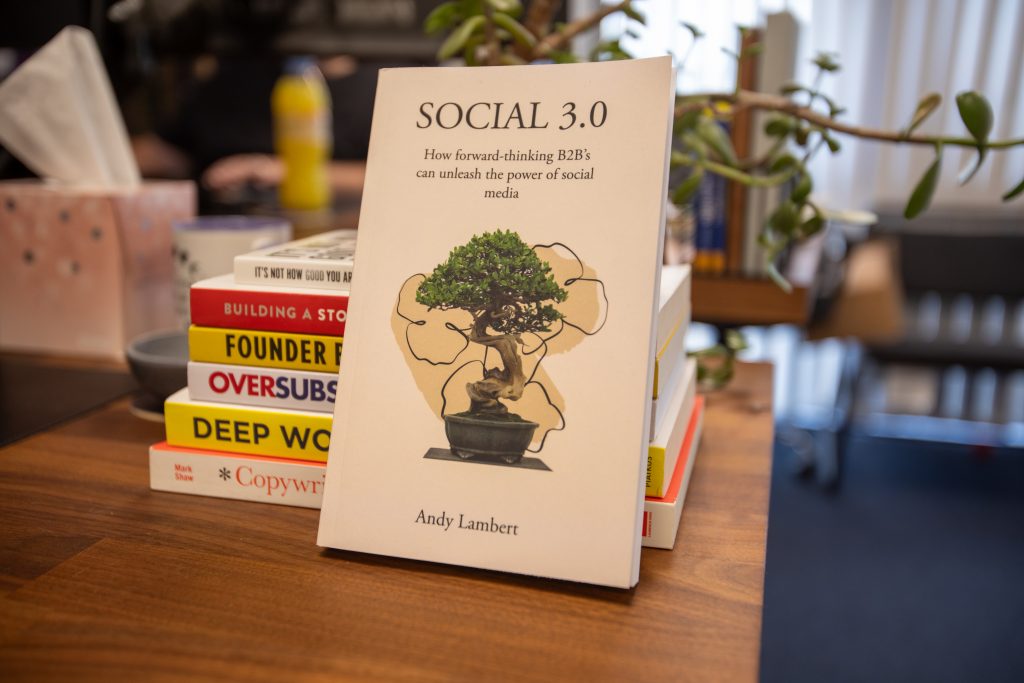A few months ago I was at a TMM webinar when Andy Lambert, social media guru and all-round good egg, mentioned that he’d written a book called Social 3.0. Immediately, I was sold. I’ve been working on some exciting social media projects recently, so it seemed like the perfect time to learn from one of the best in the industry. Thankfully, Andy did not let me down. Social 3.0 is packed with practical strategies and hard-earned knowledge, all backed up with solid case studies from his former company (and we all know how I feel about a good case study).
However, as a writer – and avid reader – I have to admit… I kinda hated it. Honestly, I’ve been tying myself into a miserable human pretzel for weeks because of how conflicted it made me feel. And ‘miserable’ and ‘pretzel’ are not words I put together lightly.
So, what’s inside?
This book has some really brilliant content. From the ‘6 C’s Framework’ to the iconic phrase ‘feral racoon child’, there’s plenty to get stuck into.
Social 3.0 covers a lot more than how to use social media. It starts with an overview of the 6 C’s Framework, which is made up of Customer, Context, Creativity, Community, Channels, and Calculation. These principles are combined in a flow chart that helps you map out your whole marketing process, making this a handy handbook for anyone creating long-term campaigns.
Andy also touches on some fascinating background topics, such as the psychology of storytelling and its chemical impact on buying behaviour, how creativity works, and the difference between marketing and sales. He even used the super-fun portmanteau ‘satisficing’ to explain why people choose the most familiar option rather than the best one. What’s not to love, right?
Throughout Social 3.0, Andy also draws on quotes and ideas from lots of cool people, from Refine Labs’ CEO to Elon Musk (although I have personally never seen the appeal of the latter). Weaving in industry giants gave the book another level of credibility and texture, which I enjoyed a lot.
There was also a really lovely bit of validation in there about the podcast service that we offer. Well, not our service specifically, but Andy said:
“In my experience, having a podcast is the single best way to meet and ask in-depth questions to those individuals that you really want to know more about. It’s an approach that leads with generosity (giving someone else a stage), helps you gather new insights and creates great content in the process. A true win-win-win.”
Given that our bread and butter is helping recruitment leaders grow their businesses with B2B podcasts, knowing that someone like Andy Lambert thinks that podcasts are a ‘win-win-win’ is pretty cool.
One of the last tips that resonated with me was to make paid social posts relevant and valuable for your audience rather than focusing on driving conversions. It’s obvious when you think about it; nobody wants to see ads on their feed, so you need to make it feel like you’re giving them something rather than just asking for their money. Somehow though, I’d not thought about it like that before.

Now I know you’re all waiting for the other shoe to drop, so here it is. While the content of the book itself is fantastic, what really got to me was the writing. It’s obvious that Andy is used to writing for an online audience with a limited attention span rather than bookworms like myself – and honestly, writing digital content is a skill. A few chapters in, though, I realised I was instinctively scanning the paragraphs like a website, which was a super weird feeling given that I’m a paper-book loyalist.
There are also so 👏 many 👏 typos. One that made me chuckle was the use of ‘phycology’ (the study of algae) in place of ‘psychology’ (the science of human minds). Also, at one point, Answer the Public was referred to as ‘Anger the Public’, which really tickled me. For the most part though, the typos were just little errors that really should have been caught by spell-check software or a proof-reader, and took away from what Andy was saying. Personally, I don’t want to find errors as early as page v.
That’s another thing – every single page number in Social 3.0 is written in Roman numerals. Not just a few pages of front matter or the introduction – the whole thing. I don’t know about you, but I don’t want to have to translate ‘xlvii’ or ‘cxcviii’ into Arabic numerals whenever I want to log my progress on Goodreads. The page numbers also aren’t capitalised, which means that they’re not even proper Roman numerals – they’re a horrible mutation that arrived at some point during the Middle Ages. Personally, I think it was a really cursed design choice.
On top of that, the book has some seriously funky layouts, including the contents page being part of the content. I mean, hot take Andy? Basically, Social 3.0 just has big self-published energy. That’s not inherently a bad thing – and as someone who did the Book Project at uni I know how hard it is to create something that looks and feels like a professionally published book. It is just a shame that so much great content was ultimately let down by its formatting.
My recommendation:
I’ve deliberately attended several webinars and courses that Andy Lambert’s spoken on, so it’s safe to say I usually like him and his style. This time though? Not so much. While the content was impeccable, the writing and formatting of Social 3.0 were just not it.
There’s so much about the book that I would recommend to people, but the typos just sent me. I also went in wanting and expecting to love it, so the number of mistakes (albeit some really funny ones) was quite disappointing. Unfortunately, unintentionally or not, Andy has, in fact, angered the public (me). Because of that, I’m only going to be able to give Social 3.0 three stars.
Rating: 💜💜💜🤍🤍
TL;DR
Social 3.0 has the bones of a brilliant book. Well, it actually has the flesh of a brilliant book, hung of the very wonky bones of a short-form writing structure and held together with enough typos and grammatical errors to give a professional writer an aneurism. If you’re not a member of the grammar police though, the book is definitely still worth a read.
Want to chat about books? Find me on LinkedIn –> Sophie Colclough 🥰



